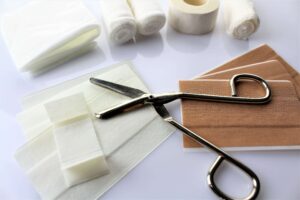Wound dressings play an essential role in wound care and healing. What you might not know is there are a wide variety of different types of wound dressings, each with its own unique characteristics that make them suitable for specific wounds. In fact, there are more than 3,000 different wound dressings to help address all the different aspects of wound care.
While a wound care specialist can help you determine the appropriate dressing for your wound, having a thorough understanding of the different types of dressings and when to use them can be crucial in promoting wound healing and preventing complications.
Introduction to Wound Dressings
 Wound dressings are materials applied to wounds to promote healing, protect them from infection, and prevent further injury. They come in different forms and types; each with its own purposes and benefits. That said, the primary function of wound dressings is to provide a moist environment for wound healing, which promotes the growth of healthy cells and facilitates the process of healing.
Wound dressings are materials applied to wounds to promote healing, protect them from infection, and prevent further injury. They come in different forms and types; each with its own purposes and benefits. That said, the primary function of wound dressings is to provide a moist environment for wound healing, which promotes the growth of healthy cells and facilitates the process of healing.
Commonly Used Wound Dressings
Let’s take a deeper look at some of the most common traditional and modern wound dressings often used in wound care. It’s important to note that some wound dressings may not be suitable for all types of wounds, and it’s always best to consult with a wound care specialist to determine the best course of treatment for a particular wound.
1. Gauze dressings
Gauze dressings are a type of traditional wound dressing made of woven cotton or synthetic fibers. They are versatile, inexpensive, and readily available, making them a popular choice for wound care. They can be used alone or in combination with other dressings to absorb wound exudate (the liquid secreted by wounds during the healing process, otherwise known as pus) and provide a protective barrier to the wound bed. However, they are not suitable for several types of serious wounds, as they can dry out and stick to the area, causing trauma and delaying the healing process.
Examples where gauze wound dressings might be used:
- Covering and protecting superficial wounds, such as abrasions or lacerations.
- Absorbing wound drainage from surgical incisions or lacerations.
- Applying topical medications to wounds using impregnated gauze dressings.
- Covering and protecting second-degree burns.
- Dressing pressure ulcers or chronic wounds with light drainage.
- Packing deep wounds or cavities with plain gauze to help control bleeding and promote clotting.
2. Non-adherent dressings
Non-adherent dressings are designed to minimize trauma and pain during dressing changes. They are made of materials that don’t stick to the wound, such as silicone or low-adherent fabrics. These types of dressings can be used for wounds with delicate or fragile tissue, such as burns, skin grafts, and donor sites. However, they may not be suitable for heavily exudating wounds or infected wounds, as they can create a warm and moist environment that encourages bacterial growth.
Examples where non-adherent dressings might be used:
- Superficial wounds such as abrasions.
- Protect burns from further damage.
- Donor sites where the skin has been removed for grafting.
- Postoperative wounds to help protect the area.
3. Hydrocolloid dressings
Hydrocolloid dressings are absorbent pads with a strong adhesive back, often used for low to moderate exudating wounds. The gel-forming agents in these dressings are highly absorbent and help keep the area moist. They help protect the wound from contamination, reduce pain, and promote wound healing.
Examples where Hydrocolloid dressings might be used:
- Pressure ulcers
- Diabetic foot ulcers
- Minor or superficial burns
- Abrasions
- Skin tears
- Donor sites
4. Foam dressings
Often made from polyurethane foam, foam dressings are often used for moderate to severe wounds. These dressings have a soft, cushioning effect and absorb a large amount of wound exudate, which helps reduce the risk of maceration.
Examples where foam dressings might be used:
- Venous leg ulcers
- Pressure ulcers
- Diabetic foot ulcers
- Surgical wounds
- Traumatic wounds
- Skin tears
- Fistulas
5. Alginate dressings
Alginate dressings are made from seaweed and contain calcium and sodium ions that create a gel-like substance when in contact with a wound.
Examples where alginate dressings might be used:
- Moderate to heavily exudating wounds
- Surgical wounds
- Traumatic wounds
- Partial thickness burn wounds
- Manage sinus tracts
6. Transparent film dressings
Transparent film dressings are thin, transparent, and waterproof, allowing for wound observation without removing the dressing. They are often made from polymer membranes that allow oxygen to reach the wound while vapor is released. Transparent film dressings can help reduce pain and protect the wound from contaminants while it’s healing.
Examples where Transparent film dressings might be used:
- Superficial wounds
- Secure and protect IV sites
- Skin tears
- Pressure ulcers
- Donor sites
- Protect post-surgical incisions
7. Hydrogel dressings
Hydrogel dressings are composed of water or glycerin and create a moist wound environment conducive to wound healing. Hydrogel dressings are a common choice for dry wounds with minimal drainage, as they can help prevent desiccation, promote autolysis, and reduce wound pain.
Examples where hydrogel dressings might be used:
- Hydrate dry or dehydrated wounds
- Manage partial thickness burn wounds
- Pressure ulcers
- Donor sites
- Radiation dermatitis
- Necrotic wounds
8. Collagen dressings
This type of wound dressing contains collagen, a protein found in the human body that facilitates healing. These dressings can be derived from animal or human sources, and are available in various forms, including gels, powders, and sheets. Collagen wound dressings can help reduce inflammation, and provide a protective barrier around the wound. However, they may not be suitable for wounds with excessive exudate, as they can become saturated and lose their effectiveness. Additionally, collagen wound dressings may not be appropriate for individuals with allergies to collagen or other animal-derived products.
Examples where collagen dressings might be used:
- Chronic wounds
- Surgical wounds
- Deep burn wounds
- Acute wounds
- Wounds with granulation tissue
9. Silver dressings
Silver wound dressings contain silver, a natural antimicrobial agent that can help prevent and treat wound infections. These dressings may contain silver in various forms, including ions, particles, or compounds, and are available in different applications, such as gels, foams, and films. While effective in some cases, prolonged use of silver wound dressings may lead to silver toxicity, which can cause skin discoloration, impaired wound healing, and other adverse effects. As such, it is important to use silver wound dressings under the guidance of a healthcare professional or wound care specialist.
Examples where silver dressings might be used:
- Infected wounds
- Chronic wounds
- Burn wounds
- Surgical wounds
- Trauma wound
10. Composites dressings
Composites wound dressings are a type of dressing that combines different materials, such as foam, hydrocolloid, and alginate, into a single dressing. These dressings are designed to provide a combination of benefits, such as absorption, moisture control, and protection, and are often used in the management of complex wounds. Composites wound dressings are particularly useful for wounds with multiple stages of healing, or for wounds that have different needs at different stages of healing. They may also be used to manage wounds with complex drainage patterns, such as fistulas or sinuses.
Specialized Wound Dressings
Specialized wound dressings are used for specific types of wounds, often during extremely serious cases. Only medical professionals administer them. Specialized wound dressings may include:
- Negative pressure wound therapy (NPWT) dressings
- Biological dressings
- Bioengineered skin dressings
NPWT dressings are advanced dressings that use negative pressure to remove excess fluid. It uses subatomic pressure to decrease exudate caused by inflammation.
Biological dressings are made from human or animal tissue or other natural sources and are used to encourage healing in severe wounds. Bioengineered skin dressings are autografts typically grown from the skin cells of the patient and are used to replace lost skin tissue.
When to Use Specific Types of Wound Dressings
 The appropriate wound dressing to use largely depends on various factors such as the wound type, the stage of healing, and the site of the injury. Wounds dressed at home will be far different from wounds dressed in a professional, wound care center. As referenced above, it’s always recommended to consult a wound specialist on the type of dressing and recommendations on changing them.
The appropriate wound dressing to use largely depends on various factors such as the wound type, the stage of healing, and the site of the injury. Wounds dressed at home will be far different from wounds dressed in a professional, wound care center. As referenced above, it’s always recommended to consult a wound specialist on the type of dressing and recommendations on changing them.
- Superficial wounds can typically be treated at home with simple dressings like gauze, plasters, bandages, and cotton wool. However, these traditional dressings can, at times, hurt when removed, as they usually adhere to the wound. They also do not provide a moist environment on their own, which is why it’s important to use a wound-healing gel or topical cream so that the site of the broken skin remains moisturized.
- Deep wounds may require advanced dressings like foam or alginate. Some of these can be bought over the counter and administered at home, but if the wound is deep or is at risk of infection, it is best to get a specialist to do it. Depending on whether the wound is secreting, needs drainage, is burning, or has a variety of other factors, a suitable dressing is determined.
- Dressings for more serious wounds can vary depending on the type of injury. For example:
- Many chronic wounds can benefit from collagen dressings
- Infected wounds may be treated with silver dressings
- Burn wounds are typically treated with specialized dressings that provide cooling and pain relief
- Pressure ulcers can be treated with dressings that reduce pressure on the affected area
- Surgical wounds typically require dressings that promote healing and prevent infection
- Traumatic wounds may require specialized dressings for tissue regeneration
- Diabetic foot ulcers may also require special dressings that promote healing and protect against infection
Additional Tips for Dressing Wounds
 When you get a cut, scrape, or any other type of wound, it’s vital to take care of it properly to help it heal and prevent infection. Here are a few additional tips for proper wound care dressing:
When you get a cut, scrape, or any other type of wound, it’s vital to take care of it properly to help it heal and prevent infection. Here are a few additional tips for proper wound care dressing:
Choose the Right Type of Wound Dressing
Choosing the right dressing is essential to ensure that your wound heals properly and to prevent the risk of infection. Factors such as the type of wound, the stage of wound healing, and the amount of fluid or exudate produced by the wound should be considered when selecting a dressing.
Clean the Wound Before Applying the Dressing
Before applying a wound dressing, it’s necessary to ensure the wound is thoroughly cleaned. You can do this with mild soap, water, or saline solution. Cleaning properly helps to remove any dirt or debris that may be present and also reduces the risk of infection. This step might be painful, so remember to be gentle.
Use Proper Application Techniques
Proper application techniques are essential for promoting healing and preventing complications. Follow the instructions provided with your wound dressing and change it as needed to ensure that your wound stays clean and protected.
Monitor the Wound for Signs of Infection
Keep an eye on the wound for any signs of infection. If you notice it before it gets worse, you’ll likely save yourself a lot of trouble in the long run. Some common signs of concern can include redness, swelling, or pus. If you notice any of these symptoms contact your wound care specialist right away.
Seek Medical Attention If Necessary
If you have a deep or severe wound, it can get worse and result in severe complications if left untreated. If you have any concerns about your wound or your wound dressing, please seek medical attention from a wound care specialist who can treat you properly.
If you have suffered from a wound or would like to learn more about what type of dressing you should be using the expert team at West Coast Wound Center is here to help. We are committed to providing high quality care to every patient we serve and can help put you on the path to healing. Book an appointment today.
